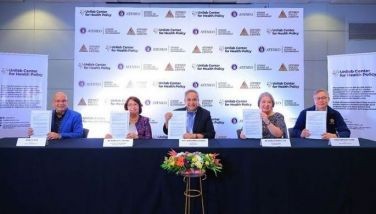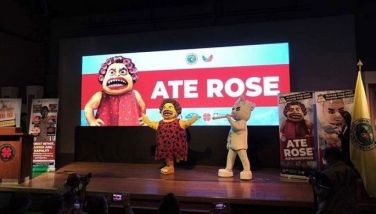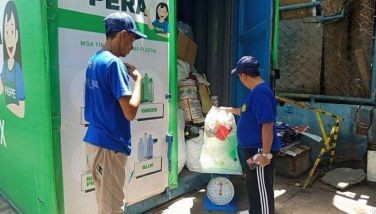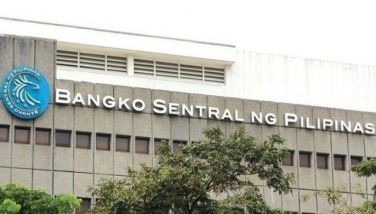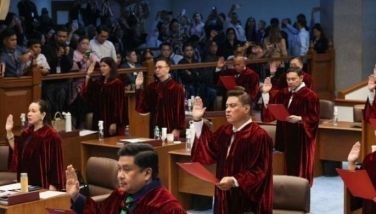What’s next after Paris (Part 2)?

With the Paris Agreement signed by close to 200 nations and officially approved last Dec. 12, the world can breathe a little easier. But do island nations, which the Philippines can identify with, really have cause to celebrate?
Going to Le Bourget in France, where the 2015 United Nations Climate Change Conference or simply COP21 was held, the Philippine contingent had high hopes of striking a better deal – at least, a version that was better than what had so far been agreed on.
And they were not disappointed. Most of the major points that had been in their agenda were accepted, and only the issue of liability remained a big thorn unresolved. This had, more or less, been expected since culpability had always been a sticky issue.
The Philippine representatives to the COP21 issued a statement at the closing plenary, citing five reasons to be grateful to all who had worked to make this most recent conference a comparative success.
New global ambition
“First, its 1.5 goal has defined the global ambition for climate action.” In climate change parlance, 1.5 refers to the temperature rise (in Celsius) that beleaguered small nations have been bargaining as the goal by which emission reduction programs of countries should be based on.
This used to be two degrees, but years of failure by previous COPs to reduce emissions had brought about more dramatic climate changes in recent years, and consequently far more serious damages.
Smaller island nations like Kiribati, which lies in the Pacific Ocean 4,000 miles from Australia with just two meters above sea level, have seen the impact of melting snows and rising waters. But if Kiribati’s islands may face immediate peril, the Philippines’ story is more protracted.
Super typhoons of increasing frequency are slowly lynching life from Filipinos who have to contend with flattened homes, disruption in economic activity, and sudden loss of kin and neighbors. Many of those hardest hit are poor, plunging them deeper into poverty.
This is why countries that stand to lose more have been bargaining for a goal of at least 1.5, and no longer two.
Climate justice
“Second, the agreement enshrines human rights as its bedrock principle,” underscoring the fact that for the very first time, the concept of climate justice has been entered and approved in an international pact.
This does not quite lead to the topic of accountability, but can be already regarded as coming one step (even if it’s a small one) closer to this ticklish (and contentious, for those who will need to pay) subject.
“Third, the agreement ensures ecosystem integrity in climate actions,” which is another conceptual battle that introduces a holistic approach in viewing negotiations on emission programs as well as damage action and reparations.
“Fourth, the agreement ensures support in finance, technology and capacity building for all adaptation and mitigation efforts.” This is basically what the $100 billion pledge is all about: developing nations being given some form of reparation for the damages brought about by climate change.
WIM Plus
“Lastly, we joined other developing countries in fighting for the inclusion of a loss and damage article in the agreement, separate from adaptation, to secure the permanence of the Warsaw International Mechanism [WIM] on loss and damage.”
WIM, which is a proposed institutionalized, operationalized mechanism on loss and damage, will continue to be pursued under improved and updated terms, now called WIM Plus.
While this could be a long, perhaps futile, debate, this would be pushed by affected countries to be able to recover and restore communities, livelihoods and ecosystems adversely affected by climate change.
For countries like the Philippines, Paris is a victory; but there’s more work that needs to be put in to really gain a true win for mankind and Mother Earth.
National Collegiate Championship day
Typhoon Nona not only brought devastation, but also wrought havoc to the 2015 National Collegiate Championship games. In view of uncertain weather conditions and in consideration of safety of students and players, one play date was cancelled (Wednesday, Dec. 16).
Despite efforts by tournament committee headed by PCCL Executive Director Joe Lipa to extend the schedule to Friday or Saturday and complete the games as scheduled, it was not possible as appropriate venues were no longer available, and the following week is the start of vacation and holidays for schools and players.
As a result, NCC games had to dispense with the battle for first and second and for third and fourth placers and to declare co-champions and joint third and fourth placers. It was the first time in 12 seasons the championship day ended in this manner. It was not ideal but realities have to be accepted, and the games have to go on.
Despite the not-so-ideal situation, credit must go to the players of the four teams that played during the abbreviated championship day. The San Beda Red Lions came out fast and led all the way to capture a back-to-back national championship. The Letran Knights were visibly affected by the change in coaching staff and the introduction of new additions to the team to replace those who graduated and even eventually drafted in the pro league.
The second game featuring UAAP champion FEU Tamaraws against its counterpart from the South, CESAFI champion University of San Carlos Warriors, stayed close up to the end as the Warriors matched the offensive and defensive moves of the Tamaraws.
Finally, the Tamaraws prevailed and earned their third national title capping a fruitful season after years of frustrations.
Prize awards for co-champions and joint third and fourth places will be shared by the teams. The prize awards, compliments of ABS-CBN Sports and Meralco (thanks to CEO Oscar Reyes and SVP Al Panlilio), are scheduled for distribution in January, with the specific date to be confirmed.
The National Collegiate Championship is sponsored by ABS-CBN, Philippine Star, Molten Balls, Fil-Oil Flying V Sports, Fog City Creamery, and Foccacia. Tickets are available at SM Tickets online.
Visit the PCCL website (CollegiateChampionsLeague.net) for more details/information and like our official Facebook fan page (Philippine College Champions League).
Facebook and Twitter
We are actively using two social networking websites to reach out more often and even interact with and engage our readers, friends and colleagues in the various areas of interest that I tackle in my column. Please like us at www.facebook.com and follow us at www.twitter.com/ReyGamboa.
Should you wish to share any insights, write me at Link Edge, 25th Floor, 139 Corporate Center, Valero Street, Salcedo Village, 1227 Makati City. Or e-mail me at reydgamboa@yahoo.com. For a compilation of previous articles, visit www.BizlinksPhilippines.net.
- Latest
- Trending










